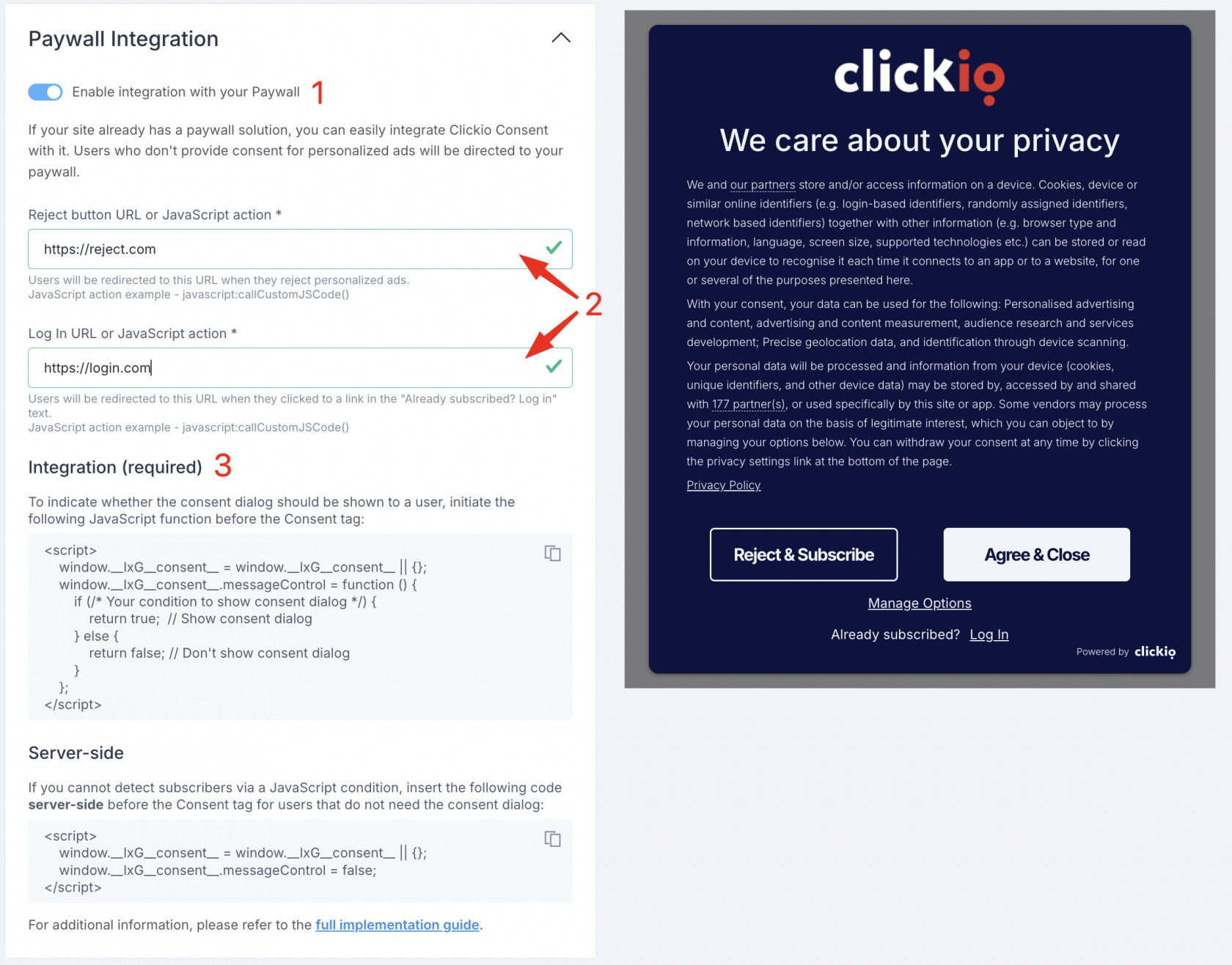Paywall Integration
Paywall Integration is available only with PRO+ / ENTERPRISE plans. Compare available plans and prices here
What is a Paywall solution?
Paywall is a digital system that allows publishers to manage access to content by putting pay-based limitations in place to prevent users from viewing website content without a paid subscription.
Why implement a Paywall Integration?
Paywall integration allows publishers to give users a choice to whether consent to personalized advertising or to sign up for a pay-based subscription. When Paywall Integration is enabled, users who do not consent to personalized advertising are directed to a subscription page to log in or signup for a subscription plan.
How to implement a Paywall integration from Clickio Platform?
1. On the Consent > Settings > GDPR (TCF) tab, enable “Paywall Integration” by setting the toggle to ON.
2. Add the URL addresses for the following fields
- Reject button URL (Paywall page URL)
- Log in URL
Additionally:
These fields can contain JavaScript code to display your own custom Paywall Pop-up or Login Pop-up. For example:
javascript:showExternalPaywall()You can add a custom "Accept Consent" button in the custom Paywall Pop-up that should call the method to apply a "Consent to all" decision:
__lxG__consent__.consentToAll()Note that this method only works when the Paywall Integration is active, the Clickio consent pop-up is displayed, and the user previously rejected consent.
3. Implement the following codes on your website:
In order to disable the Consent dialog for users who are already subscribed, call the following Javascript method:
<script>
window.__lxG__consent__ = window.__lxG__consent__ || {};
window.__lxG__consent__.messageControl = false;
</script>This code should be implemented on the Login Page if there are no ads and Clickio Consent is loaded on the page.
Notice that __lxG__consent__.messageControl can take the following values:
- Boolean (true/false): A simple flag that determines whether to display the popup. It can be set server-side during page generation or executed via IIFE.
- Function returning boolean: A synchronous function that must return a boolean when executed. The Clickio Consent calls this function when checking whether to display the popup.
<script>
window.__lxG__consent__ = window.__lxG__consent__ || {};
window.__lxG__consent__.messageControl = function () {
if (/* Your condition to show consent dialog */) {
return true; // Show consent dialog
} else {
return false; // Don't show consent dialog
}
};
</script>- promise: A promise that is fulfilled or rejected depending on whether the popup should be displayed.
- Function returning promise: A function that must return a promise, which will be fulfilled or rejected depending on whether the popup should be displayed.
When the Clickio Consent logic identifies that the messageControl attribute has been defined, it is utilized to determine whether the popup should be displayed to the user or not. If the answer is affirmative, regular Clickio Consent checks are carried out (such as whether consent has already been given, the date of consent, and so on) to arrive at a final decision. Therefore, even if the messageControl attribute results in true, the popup may not be displayed.
If the user is not given a chance to consent (messageControl results into false) and there is no previous consent detected, Clickio Consent logic will report the consent state as not determined via TCF v2 API and that may break 3rd party code functionality
Setting the optional flag window.__lxG__consent__.messageControlShowPopupOnNoConsentString = true in combination with window.__lxG__consent__.messageControl = false triggers the CMP to automatically prompt all subscribers who haven’t made a consent decision yet. However, subscribers still retain the ability to reject consent, which, for example, can prevent personalized ads from being displayed.

